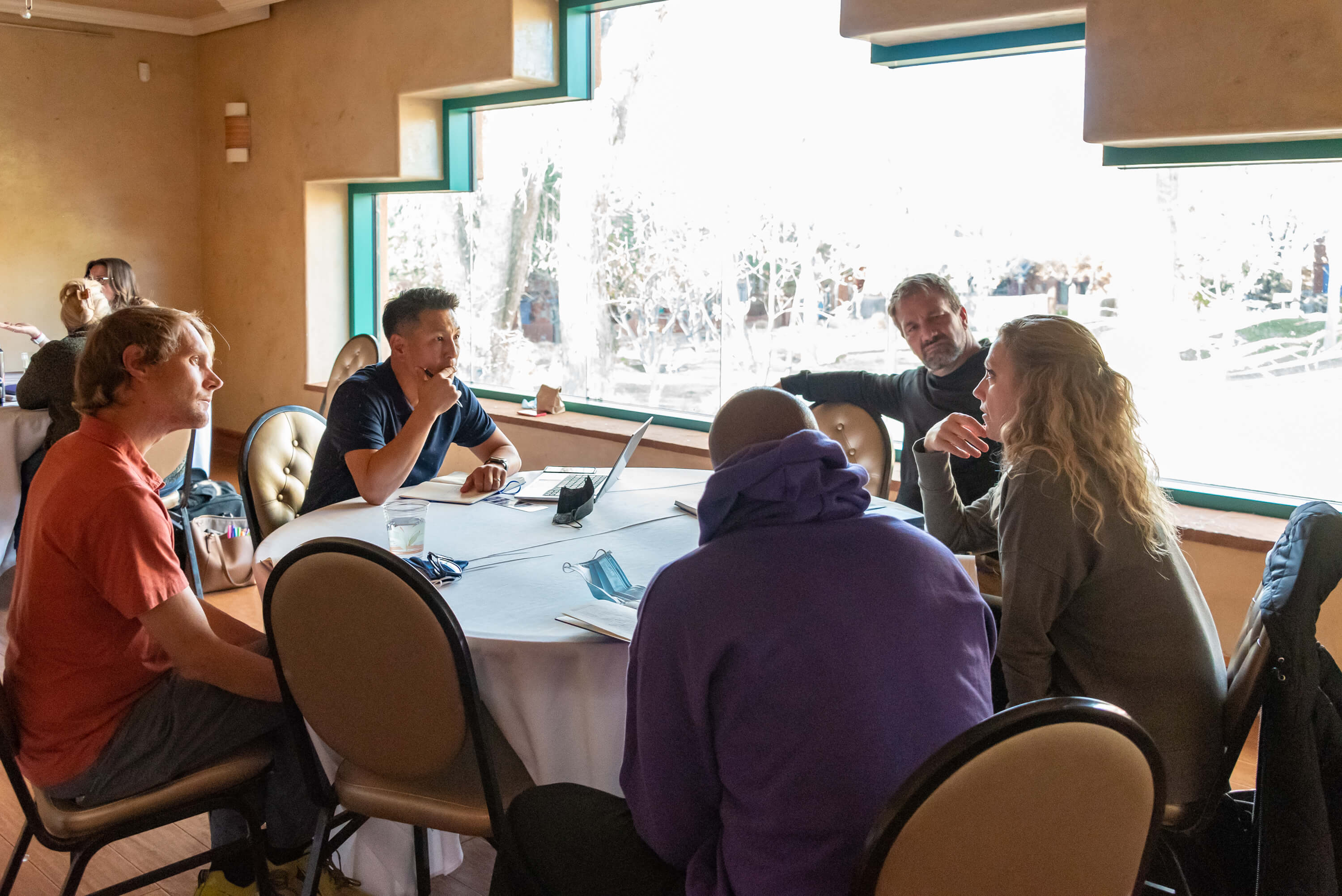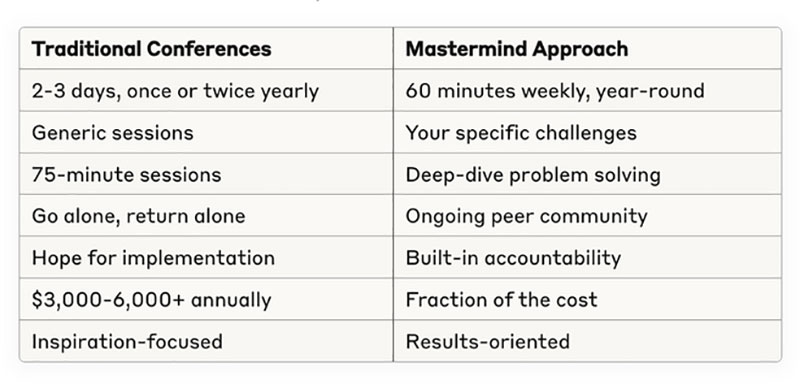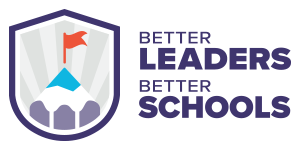
Last year, I watched a brilliant principal drop $6,200 on conferences.
NAESP’s national conference in Nashville. Registration: $1,095. Flight and hotel: $1,200. NASSP’s leadership summit in Chicago three months later. Another $1,100 registration plus $850 in travel costs. Then the state association conference, an ASCD event, and two “can’t-miss” regional workshops.
By December, she’d filled three binders with notes and collected 47 business cards. Attended countless sessions.
You know what changed on her campus?
Nothing.
Her teachers were still burning out. Her test scores flatlined. And she was more exhausted than ever. She texted me and asked why all that “professional development” left her feeling like she was still flying solo.
Sound familiar?
Here’s the brutal truth nobody wants to say: The traditional conference circuit is failing school leaders.
And it’s not because the presenters aren’t smart or the content isn’t valuable. It’s because the entire model is broken.
The Conference Industrial Complex
National Association of Elementary School Principals (NAESP)
Your content goes here. Edit or remove this text inline or in the module Content settings. You can also style every aspect of this content in the module Design settings and even apply custom CSS to this text in the module Advanced settings.
National Association of Secondary School Principals (NASSP)
Learning Forward
AASA (American Association of School Administrators)
ASCD
Then you’ve got dozens of regional and state-specific events, edtech conferences, and specialty workshops targeting everything from “21st-century learning” to “data-driven decision making.”
Do the math: The average principal attending three major conferences annually spends $2,500-4,500 on registration alone. Add travel, lodging, meals, and lost instructional time, and you’re looking at $6,000-8,000 per year.
Districts spend $18 billion annually on professional development. That’s billion with a B.
The Problem with Conference Culture
Here’s where it gets interesting.
Despite this massive investment, most principals report that traditional PD doesn’t help them become more effective leaders.
Why not?
It's Too-Little-Too-Late
You spend 2-3 days getting inspired, then return to your campus where reality hits like a freight train. The same difficult parent is waiting in your office. The same teacher is still struggling with classroom management. The same district bureaucracy is still demanding reports that nobody reads.
That conference high? It lasts about 48 hours.
Real leadership development isn’t about inspiration binges. It’s about consistent, sustained growth over time. But conferences are built on the opposite model — massive information dumps followed by months of radio silence.
It's Unhelpful
Most conference sessions are designed for the mythical “average principal” leading the hypothetical “typical school.” But your challenges are specific. Your campus culture is unique. Your community has particular needs.
Session titles like “Transforming School Culture Through Data-Driven Collaboration” sound impressive. In practice, they’re often generic frameworks that don’t address the messy reality of your specific situation.
When was the last time you attended a breakout session that solved the problem keeping you awake at night?
It's Disconnected
You go alone. You learn alone. You return alone. You try to implement alone.
Most principals don’t have meaningful mentorship or peer support systems. So when you return from a conference with a binder full of great ideas, who helps you figure out which ones will actually work in your context? Who holds you accountable for following through? Who do you call when implementation gets difficult?
The conference model assumes you’ll figure it out yourself. That’s not leadership development— that’s hope disguised as strategy.
The Science of Why Conference Learning Doesn’t Stick
Let me share something most conference organizers don’t want you to know: The research on traditional professional development is damning.
Studies show that one-shot workshops and conferences produce minimal behavior change.
Here’s what happens in your brain during a typical conference:

Information Overload:

The Forgetting Curve:
Without reinforcement, you’ll forget 50% of what you learned within an hour, and 90% within a week. That’s not a character flaw — that’s neuroscience.

Implementation Lag:

No Feedback Loop:
When you attempt to implement something new, there’s no coach or mentor to help you troubleshoot. When things don’t work out, you abandon the effort and return to familiar patterns.
This isn’t your fault. It’s a design flaw in the conference model itself.
What Actually Creates Transformation
I’ve been in education long enough to watch hundreds of principals chase the conference circuit. The ones who actually transform their schools? They do something different.
They understand that Community Fuels Confidence.
Instead of annual inspiration binges, they invest in ongoing relationships. Peers who challenge their thinking, hold them accountable, and help them work through real problems in real time.
Instead of generic best practices, they get specific feedback on their challenges from people who’ve walked in their shoes.
Instead of hoping they’ll remember and implement what they learned, they engage in weekly touchpoints that ensure consistent growth and follow-through.

The Weekly Advantage
Here’s a radical idea: What if instead of spending three days once a year getting inspired, you invested one hour every week getting better?
Fifty-two weeks of consistent growth, peer feedback, and targeted problem-solving vs. two days of information overload.
Which approach do you think creates lasting change?

Peer Learning vs. Expert Presentations
Don’t get me wrong — I respect conference presenters (and I am one!). Many are brilliant educators with valuable insights. But there’s something powerful about learning from practitioners who face the same daily challenges you do.
When another principal shares how they handled a difficult parent situation, you’re not getting a strategy. You’re getting battle-tested wisdom from someone who understands the context of your work.

Your Problems, Not Generic Solutions
Every school is different. Your community, your staff, your students, your challenges — they’re all unique. Cookie-cutter solutions from conferences often fail because they weren’t designed for your specific context.
But when you can bring your actual challenges to a group of experienced peers and get tailored feedback?
That’s when breakthrough happens.
The Conference Trap vs. The Mastermind Advantage

Scenario A: The Conference Principal
Sarah attends NAESP in March. She’s inspired by sessions on innovative scheduling and returns with plans to revolutionize her master schedule. But when she tries to implement changes, her assistant principal raises concerns she hadn’t considered. Her teachers push back. The district questions the approach.
With no ongoing support system, Sarah abandons the project by May. Come August, she’s looking at the NASSP conference brochure, hoping this year will be different.

Scenario B: The Mastermind Principal
Mike faces the same scheduling challenges. But instead of waiting for a conference, he brings the issue to his weekly mastermind call. Seven experienced principals from across the country help him think through the obstacles. They share what worked (and what didn’t) in their schools. One connects him with a principal who successfully implemented a similar change.
Over six weeks, Mike refines his approach with weekly feedback from his peer group. By the time he presents to his staff, he’s anticipated their concerns and has real examples from other schools to share. Implementation succeeds because it was designed collaboratively, not in isolation.
The Numbers Tell the Story

Why Elite Leaders Choose Ongoing Mentorship
I’ve worked with thousands of school leaders over the past decade.
The ones who create legendary campus experiences — the principals whose schools other educators want to visit, whose teachers never want to leave, whose students are excited about learning — they all share something in common.
They don’t rely on conferences for their professional growth.
Instead, they invest in relationships and systems that support continuous improvement. They understand that leadership development isn’t an event. It’s a process.

The Hot Seat Protocol
On the hot seat you share your biggest leadership challenge. A group of experienced principals who committed to your success help you solve it.
For 20 minutes, that challenge becomes the entire group’s focus. Brilliant minds work together to help you see angles you missed, share strategies they’ve tested, and hold you accountable for taking action.
This not theory. We’ve been facilitating this kind of real-time problem solving since 2016.

The Power of Weekly Touchpoints
Small, consistent actions compound over time. A weekly 60-minute investment in your growth creates 40+ hours of development annually — more than most principals get from all their conferences combined.
But it’s not just about the hours. It’s about the consistency. When you know you’ll have support and accountability every week, you’re more likely to try new approaches, take calculated risks, and push yourself outside your comfort zone.

Results-Oriented vs. Inspiration-Focused
Conferences make you feel good. Masterminds make you better.
The difference matters.
When you’re part of a group that measures success by the results you create on your campus —not the notes you take or the sessions you attend — everything changes.
Your mindset shifts from “I hope this works” to “We’re going to figure out how to make this work.”
The ABCs of Powerful Professional Development®
After years of studying what actually creates transformation in school leaders, I’ve identified three non-negotiables for effective professional development:

Authenticity:

Belonging:

Challenge:
You need people who will push your thinking, question your assumptions, and hold you to a higher standard. Conference sessions rarely challenge you — they share general principles you can take or leave.
When you combine authenticity, belonging, and challenge in an ongoing development model, magic happens.
Not the inspiration-high kind of magic that fades by Tuesday. But the sustainable transformation kind that changes how you lead.
The Conference Question Every Principal Should Ask
Here’s the question that separates Play-It-Safe-Principals from Ruckus Makers:
“Is this conference going to help me create the campus experience my students deserve?”
Be honest.
How many conferences have you attended where the biggest takeaway was validation that you’re already doing good work?
How many sessions have you sat through thinking, “This sounds great in theory, but it would never work in my school”?
Real professional development doesn’t make you feel better about your current reality. It gives you the tools, support, and accountability to create a different reality.

The Status Quo Trap
Most conferences inadvertently reinforce the status quo.
They teach you how to be a better administrator — how to manage budgets more efficiently, run meetings more effectively, navigate district politics more smoothly.
But what if the goal isn’t to be a better administrator?
What if the goal is to be a visionary leader who reimagines what school can be?
There’s no session at NAESP called “How to Disrupt Your Own System.”
There’s no breakout at NASSP titled “Leading Change When Your District Wants Compliance.”
Because conferences are designed for the masses. And the masses aren’t ready for disruption.

Ruckus Makers Do School Different
If education ain’t a bit disruptive, then what are your students really learning?
That question changes everything.
It shifts your focus from maintaining the system to transforming it. From managing compliance to inspiring innovation. From administrative efficiency to educational excellence.
And that shift requires a different kind of professional development. Not the kind you get in hotel conference rooms surrounded by hundreds of other principals. The kind you get in small groups of committed leaders who’ve decided to Do School Different.
The $18 Billion Question
Districts spend $18 billion a year on professional development that most principals say doesn’t help them. Let that sink in.
Eighteen. Billion. Dollars.
What if even 10% of that investment went toward ongoing mentorship and peer learning instead of one-shot workshops and conferences?
What if principals had access to the kind of sustained, personalized development that actually creates change?
The truth is, districts keep funding conferences because they’re easy to measure and budget. You can count attendees, track CEU hours, and check boxes on compliance reports.
But you can’t measure transformation on a spreadsheet.
You can’t quantify the moment a principal shifts from playing it safe to making a ruckus. You can’t put a number on the impact of sustained peer mentorship.
So the cycle continues.
Billions spent on professional development that develops very little. Principals who attend conferences hoping this time will be different. And students who deserve better than the status quo getting more of the same.
Your Next Step
Most principals will read this article, nod in agreement, and register for the next conference anyway.
Because that’s what Play-It-Safe-Principals do. They follow the crowd, check the boxes, and hope inspiration strikes twice.
But you’re not most principals.
If you made it this far, you’re someone who questions the system.
Someone who suspects there might be a better way. Someone ready to stop chasing conference highs and start creating sustainable transformation.
You’re a Ruckus Maker.
And Ruckus Makers don’t settle for the status quo — even in their own professional development.
The Ruckus Maker Mastermind isn’t another conference. It’s not another workshop series. It’s not another binder full of good ideas you’ll never implement.
It’s a year-long journey with a small group of visionary principals who’ve committed to doing more than just improving their schools. They’re committed to reimagining them.
Every week, you’ll join calls where the only agenda is solving your biggest challenges.
Where other practicing principals share not just what works, but what doesn’t — and why.
Where you’ll get the kind of personalized feedback and accountability that turns good ideas into great results.
This isn’t about collecting certificates or networking over coffee. It’s about surrounding yourself with leaders who won’t let you settle for ordinary.
Leaders who believe, like you do, that if education ain’t a bit disruptive, then what are their students really learning?
The Choice Is Yours
You can keep doing what you’ve always done.
Register for conferences, take notes, hope for the best. Spend thousands of dollars on professional development that develops very little.
Or you can join the small group of principals who’ve discovered that the best professional development doesn’t happen in hotel conference rooms.
It happens in community with other leaders who’ve decided to Do School Different.
Ready to stop chasing conference highs and start creating lasting change?
The Ruckus Maker Mastermind is accepting applications for our next cohort. But we don’t accept everyone. This isn’t for principals who want to improve the status quo.
Apply to The Ruckus Maker Mastermind
Because your students deserve more than another conference binder collecting dust on your shelf.
They deserve a Ruckus Maker.
Are you ready to Do School Different? The future of education isn’t found in conference halls — it’s created by leaders bold enough to reimagine what’s possible.


